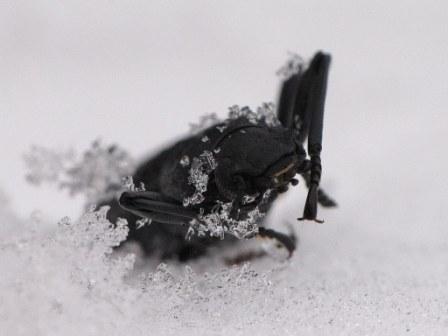Icicles and insects
Winter is a hard time for many animal species including insects. However, some insects have developed different strategies for coping with the cold months.

Some insects avoid being frozen by changing their behaviour, for instance becoming less active and finding a warm, dry site to hibernate. Others are able to tolerate the freezing temperatures, remaining unfrozen and active by changing their biochemistry. Supercooling is an example of one of these changes, where water in the insect’s gut cools below its freezing point without changing into a solid due to the lack of dust or food particles for the ice crystals to form around. Some insects are capable of being entirely frozen and can control the extent of freezing occuring in their bodies, usually starting the process at fairly high temperatures through the use of proteins or microbes.
Many species that cannot cope with the freezing temperatures migrate great distances to warmer countries where they will usually mate. However, insect migration is different from bird migration since their short lifespan means that the adult that made one leg of the trip will be replaced by a member of the next generation on the return voyage! One of the most famous migratory insect species in the world is the Monarch butterfly which can travel a staggering 3,o00 km between areas of North America as far north as Canada, all the way to their overwintering sites as far south as Mexico!
Bye for now!
Alex Kekewich – Assistant Ranger at Falls of Clyde
Help protect Scotland’s wildlife
Our work to save Scotland’s wildlife is made possible thanks to the generosity of our members and supporters.
Join today from just £3 a month to help protect the species you love.
Preface
Winter is a hard time for many animal species including insects. However, some insects have developed different strategies for coping with the cold months. Some insects avoid being frozen by …
